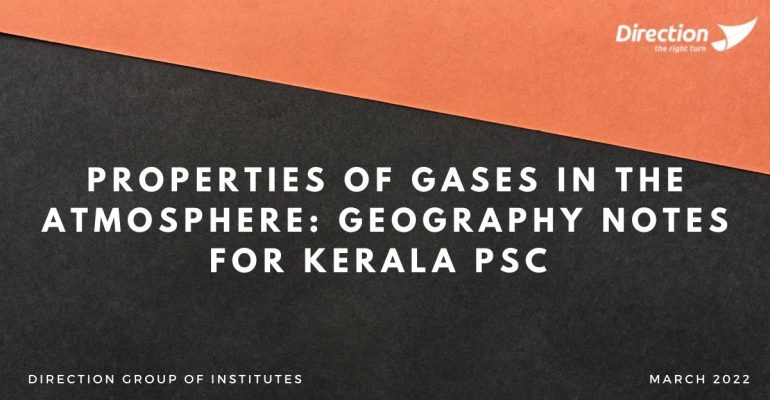Properties of Gases in the atmosphere: Geography Notes for Kerala PSC
March 31, 2022 2022-03-31 12:32Properties of Gases in the atmosphere: Geography Notes for Kerala PSC
Air is a mixture of different gases in varying proportions. The two important gases in the atmosphere are Nitrogen and Oxygen. Nitrogen is composed of 78 percent of the total gases in the atmosphere while oxygen comprises 21 percent. The remaining one percent includes Argon, Carbon dioxide, ozone, Water vapour and many other gases. Of the many constituents, the most important for earth’s climatic conditions are water vapour, dust, Carbon dioxide and Ozone
| Gases | Percentage |
| Nitogen | 78.08% |
| Oxegen | 20.95% |
| Argon | 0.93% |
| Carbon dioxide | 0.036% |
| Neon | 0.002% |
Properties of Gases in the atmosphere
Nitrogen
- Nitrogen is the most plentiful gas in the air.
- Nitrogen is essential for the survival of plants. But Plants can not take nitrogen directly from the air. It is bacteria, that live in the soil and roots of some plants, take nitrogen from the air and change its form so that plants can use it.
Oxygen
- Oxygen is the second most abundant gas in the air.
- Humans and animals take oxygen from the air as they breathe. Green plants produce oxygen during photosynthesis. In this way oxygen content in the air remains constant.
Carbon dioxide
- Green plants use carbon dioxide to make their food and release oxygen. Humans or animals release carbon dioxide while respiration.
- Carbon dioxide is transparent to the incoming solar radiation but opaque to the outgoing terrestrial radiation.
- It absorbs a part of terrestrial radiation and reflects back some part of it towards the earth’s surface.
- Carbon dioxide is largely responsible for the greenhouse effect.
- While the volume of other gases is constant, the volume of carbon dioxide has been rising in the past few decades. It is mainly because of the
- burning of fossil fuels. This results in an increase in the temperature of the air.
Oxone
- Ozone is found between 10 and 50 km above the earth’s surface.
- It acts as a filter that absorbs the ultraviolet rays radiating from the sun and prevents them from reaching the surface of the earth.
- The nitrous oxide released by jet planes, cholorofluro carbon (CFC) and Hydro Cholofluro carbon released by air conditioners, refrigerators etc are harmful to the Ozone layer.
Inert gases
- Of the inert gases, the most important is argon. By volume, it forms about 0.93 per cent of the atmosphere.
- Other inert gases include Neon, Helium, Krypton and Xenon, all of which has no significance in the weather processes of the earth











